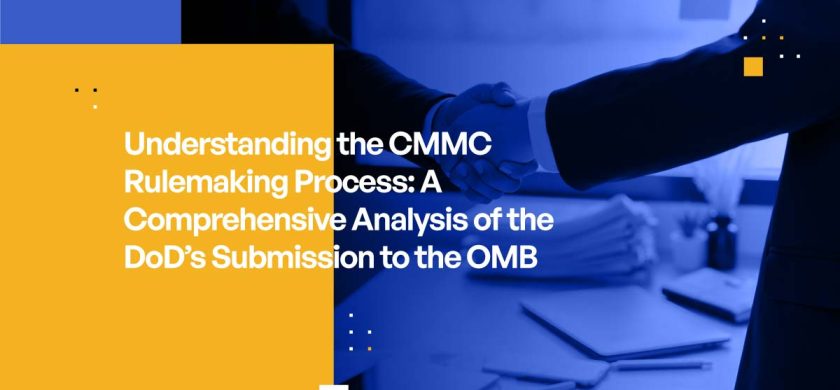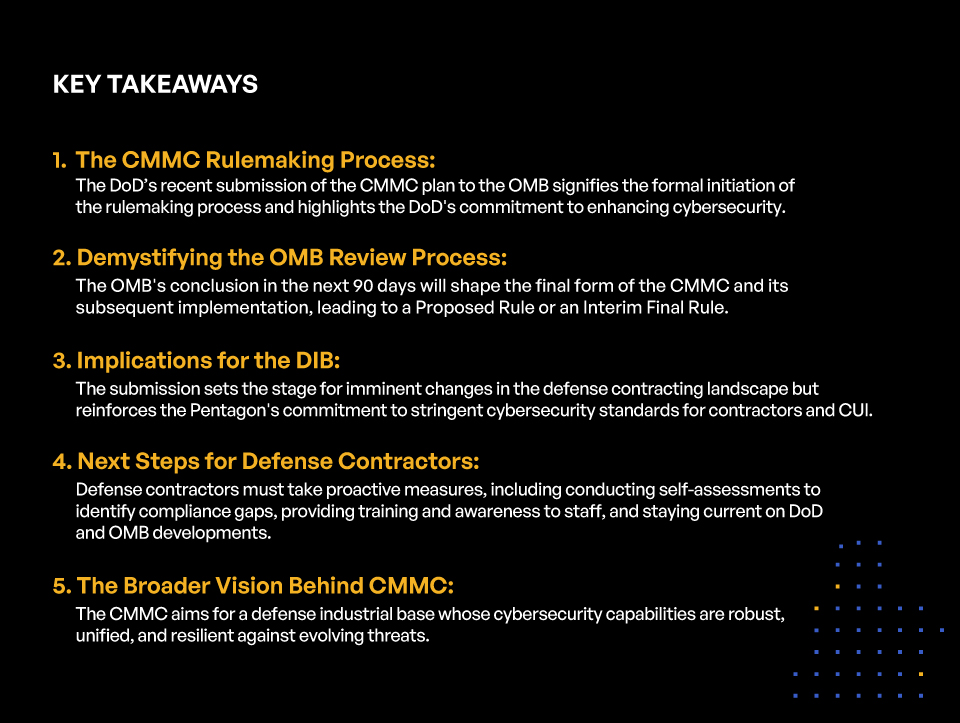
Understanding the CMMC Rulemaking Process: A Comprehensive Analysis of the DoD’s Submission to the OMB
In the realm of cybersecurity, few topics have garnered as much attention and discussion as the Cybersecurity Maturity Model Certification (CMMC). As defense contractors and stakeholders eagerly await updates, the Department of Defense’s (DoD) recent submission to the Office of Management and Budget (OMB) has added a new layer of intrigue and anticipation to the narrative. This blog offers a detailed exploration of this development and its broader implications for the defense sector.
The CMMC: A Brief Overview
Before delving into the recent developments, it’s essential to understand the CMMC’s genesis and objectives. Introduced as a unified cybersecurity standard, the CMMC aims to bolster the protection mechanisms around sensitive defense information within the U.S. defense supply chain. Given the increasing sophistication of cyber threats, the DoD recognized the need for a comprehensive and standardized approach to cybersecurity, leading to the birth of the CMMC.
The CMMC certification process is arduous but our CMMC 2.0 compliance roadmap can help.
The Monumental Submission to OMB
The DoD’s decision to submit its CMMC plan to the OMB is not a mere administrative step. It signifies the culmination of extensive deliberations and preparations, marking the formal initiation of the rulemaking process for the CMMC program. This submission is a testament to the DoD’s commitment to fortifying its cyber defenses and ensuring that its contractors are aligned with this vision.
Decoding the OMB Review Process
With the CMMC framework now under the OMB’s purview, what can stakeholders expect? The OMB’s Office of Information and Regulatory Affairs has a maximum of 90 days to review the submission. This review will be instrumental in shaping the CMMC’s final form and its subsequent implementation.
Once the review concludes, the rule will find its way to the Federal Register, where it can take one of two routes:
1. Proposed Rule
(More likely) If OMB publishes a CMMC Proposed Rule, then a 60-day public comment period is required before the OMB and DoD may begin to implement the rule. This is the most likely path anticipated by those watching the process, including many in industry. Under this path, after the 60-day comment period closes, we are looking at somewhere between 280 and 333 business days, on average, before DoD begins phasing in CMMC into its contract requirements, based on the DoD’s recent track record, according to Horn. So, a September/October publication of a Proposed Rule would place a phased CMMC implementation beginning in Q2 FY 2025, possibly Q3.
2. Interim Final Rule
(Less likely) OMB could choose to release an Interim Final Rule, which allows the OMB and DoD to begin rolling out CMMC into contract requirements while they review public comments, i.e., in parallel. Therefore, choosing an Interim Final Rule means that CMMC could begin to be added to DoD contracts in Q1 of FY 2024, because such rules are effective immediately upon publication. This is the less likely/anticipated scenario, but it is possible.
Regardless of the chosen trajectory, a period for public comments is a certainty, offering stakeholders a platform to share feedback and insights.

KEY TAKEAWAYS
- The CMMC Rulemaking Process:
The DoD’s recent submission of the CMMC plan to the OMB signifies the formal initiation of the rulemaking process and highlights the DoD’s commitment to enhancing cybersecurity. - Demystifying the OMB Review Process:
The OMB’s conclusion in the next 90 days will shape the final form of the CMMC and its subsequent implementation, leading to a Proposed Rule or an Interim Final Rule. - Implications for the DIB:
The submission sets the stage for imminent changes in the defense contracting landscape but reinforces the Pentagon’s commitment to stringent cybersecurity standards for contractors and CUI. - Next Steps for Defense Contractors:
Defense contractors must take proactive measures, including conducting self-assessments to identify compliance gaps, providing training and awareness to staff, and staying current on DoD and OMB developments. - The Broader Vision Behind CMMC:
The CMMC aims for a defense industrial base whose cybersecurity capabilities are robust, unified, and resilient against evolving threats.
Implications for the Defense Contracting Ecosystem
The DoD’s submission has set the wheels in motion, signaling imminent changes in the defense contracting landscape. While the exact contours of the final CMMC rule remain to be seen, one thing is clear: change is on the horizon.
The CMMC is not merely a regulatory hurdle. It embodies the Pentagon’s vision for a robust cybersecurity posture, ensuring that contractors handling its controlled unclassified information (CUI) adhere to stringent standards. These standards resonate with the National Institute of Standards and Technology’s guidelines, particularly NIST 800-171 and 800-172.
Preparing for the Future: Steps for Defense Contractors
With the CMMC’s rulemaking process underway, defense contractors must adopt a proactive stance. This involves:
- Self-assessment: Understanding current cybersecurity measures and identifying gaps in compliance
- Training and Awareness: Ensuring that staff and stakeholders are aware of CMMC requirements and their implications
- Engaging Experts: Considering collaborations with cybersecurity experts to navigate the complexities of CMMC compliance, including a CMMC Third Party Assessor Organization (C3PAO) to conduct an assessment or recommend CMMC certification
- Staying Updated: Regularly monitoring updates from the DoD and OMB to remain abreast of developments
The DoD’s submission to the OMB marks a significant milestone in the CMMC journey. As defense contractors await further clarity, it’s imperative to recognize the broader vision behind the CMMC—a future where the defense sector’s cybersecurity mechanisms are robust, unified, and resilient against threats.